ASTR 1210 (O'Connell) Study Guide
22: IMPACTS AND BIO-EXTINCTIONS
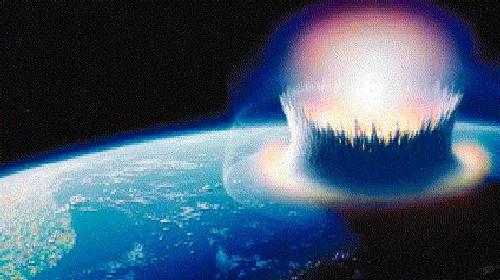
Impact of a "planet buster" asteroid
(Don Davis)
upon us suddenly out of space." --- H. G. Wells
A. History
With the arrival of a scientific assessment of sky phenomena, the supernatural cosmic cataclysms imagined in earlier times were cast off as the superstitions that they were. The cosmos became regarded as mostly benign, apart from a few skeptics like H. G. Wells. It was hard to conceive of Earth being threatened by any extraterrestrial event short of a major change in the Sun. But recognition of a huge, unforeseen, genuine cosmic threat from another quarter emerged in the mid-20th century. Until that time, craters on the Moon and Earth were usually interpreted as having a volcanic origin even if they were not located in volcanically active regions. Recall that until the first spacecraft reconnaissance in the mid-1960s's, there was no direct evidence for craters on other planets (the Moon excepted).- Then, in 1960 Eugene Shoemaker, by comparing the structure of
the Barringer Crater in
Arizona & others to nuclear bomb craters and discovering the presence
of shock-heated minerals,
demonstrated that most isolated craters were formed in explosive
impacts by extraterrestrial bodies, not vulcanism.
This revealed that the history of the Earth and solar
system was even more violent than had been supposed. We now know that
craters cover the surfaces of
almost all solid bodies in the solar system and that most of these
were produced by a devastating rain of impactors.
- Based on geological evidence described below, this paper argued that the major extinction of lifeforms 65 million years ago, including the dinosaurs, was produced by the impact of a single moderate-sized asteroid.
- Although the dangers of extraterrestrial impacts had been speculated about before, this study provided the first direct evidence for a link to worldwide biological extinctions.
- Many geologists and paleontologists have argued for other, non-astronomical, mechanisms for extinctions, such as the massive volcanic outbreak at the Deccan Traps, which might have caused a sudden extreme greenhouse event.
- Earth moves continuously at high speed through a swarm of asteroids, meteoroids, and comet nuclei, for example the "Apollo," "Aten," and other types of Earth orbit-crossing asteroids.
- The unambiguous conclusion is that major impacts are inevitable! The question is not if?, but when?
- The areal density of lifetime impacts on the Earth's surface for craters over 500-m diameter is higher than that on the Moon. See this illustration of the impact density.
- Finally, the energy deposited by big asteroids is large enough that the destructive effects can be global.
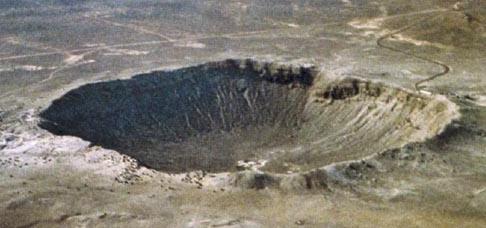
The Barringer "Meteor Crater," near Winslow, AZ.
B. Direct Evidence for Major Impacts on Earth
Ancient Impacts
- Fossil Craters
- From spacecraft images, we are now aware of the ferocious impact
history of the surfaces of all other solid bodies investigated
so far in the Solar System (e.g. Mars,
Jupiter's moon Callisto, and of
course, our own Moon).

- Owing to weathering and crust recycling, older craters have been mostly erased from Earth's surface.
- Nonetheless, we have been able to identify over 150 large fossil craters in regions where older geological strata are exposed. E.g. at right is Manicouagan Crater, Canada. This Space Shuttle image shows a 43 mile diameter annular lake (in winter), part of a 62 mile diameter crater structure. Age: 210 million years.
- The Barringer Crater (shown above) is the best preserved and accessible large impact crater in the US. It is 3/4 mile in diameter and 560 feet deep. It was created by the impact of a 50-m diameter metallic meteoroid about 50,000 years ago. The largest recovered fragment of the impactor is known as the Holsinger Meteorite.
- From spacecraft images, we are now aware of the ferocious impact
history of the surfaces of all other solid bodies investigated
so far in the Solar System (e.g. Mars,
Jupiter's moon Callisto, and of
course, our own Moon).
- Impact geology. Shocked & melted rocks or other debris
characteristic of the sudden
high temperatures or pressures that occur in an impact but
which go beyond what is encountered in volcanic eruptions have been
identified in and near impact craters. In some cases, these can be
found at
large distances
from the point of impact. Signatures of impact geology have been identified at
many locations worldwide.
- E.g. Coesite, a form of shocked quartz, was found by Shoemaker and Chao in the Barringer Crater. It can only be formed at temperatures of about 1400 C and pressures over 40000 times normal air pressure.
- E.g. Tiny spherules embedded in thin rock layers that originated from molten droplets of rock flung into the atmosphere by explosive impacts. Recent samples found in Australia date from an asteroid impact 2.6 billion years ago.
- E.g. In our own Virginia neighborhood, submerged debris from a Chesapeake Bay impact event 35 million years ago, which produced a 56 mile-wide crater and tidal waves estimated to be 1000 ft high swamping a huge surrounding region.
Continuing Impacts
- Observed near misses (last 50 years)

-
Some large meteoroids have been seen passing through our atmosphere
without striking the surface. At right is a picture taken Aug 10,
1972 in Grand Teton National Park of a near-miss (click for
enlargement). The object is about 10-m diameter and at an altitude of
about 55 km, moving at 15 km/sec (33,000 MPH). It approached at such
a shallow angle that it skipped off the atmosphere. If it had hit the
Earth, it would have had H-bomb equivalent impact energy.
There have now been many telescopically-observed near misses
within twice the distance of the Moon.
- A complete list of these, including predicted passages, is given here, and links to other useful lists are given at the bottom of this page.
- Some interesting examples:
-
2011 CQ1: a small 1-m diameter
meteoroid that came within 3,400 miles of Earth's surface on 4 Feb 2011.
2005 YU55: a 400-m asteroid
that passed within 202,000 miles (inside the Moon's orbit) on 8 November 2011.
Largest known near-miss object until 2028.
2012 DA14: a
passage of a 45-m meteoroid at a distance of only 17,000 miles, inside the
geosynchronous satellite belt(!), on 15 February 2013.
- Witnessed impacts.
- Tunguska, Siberia 1908:
the biggest recorded hit
- Energy release: equivalent to ~20 million tons of TNT. [One million tons, or one "megaton," is the explosive energy of a typical hydrogen bomb.] Tunguska was 1000 x the energy release of the Hiroshima atomic bomb ("only" 20,000 tons).
- The explosion flattens an area the size of Washington, DC.
- Likely cause: air detonation (altitude 10 km) of a stony meteoroid about 30 m in diameter
- Tunguska Redux (Chelyabinsk meteoroid, 15 February 2013)
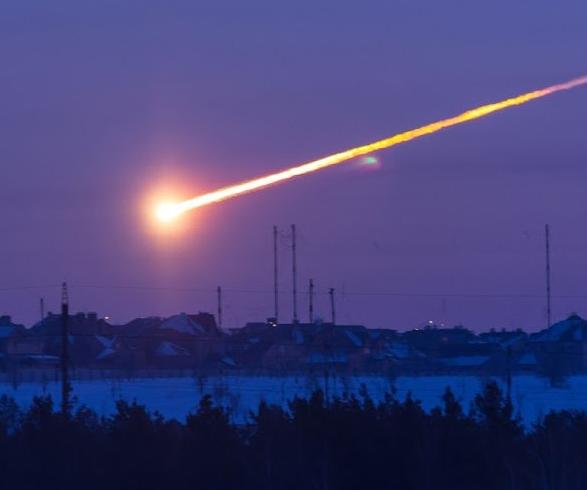
- In a near-replay of the Tunguska event, a 20-m diameter meteoroid (see picture at right) exploded over Chelyabinsk, Russia, at an altitude of 23 km (14 miles). The shock wave overpressure from the explosion caused extensive structural damage and produced a number of injuries (but no deaths).
- The explosive energy of the meteoroid was equivalent to about 450,000 tons of TNT. It was smaller than Tunguska because the incoming body was smaller and had a lower velocity. It also exploded at a higher altitude, reducing effects at the ground level. The event, however, was a sobering reminder of the impact threat from space.
- The incoming meteoroid had not been detected before impact because of its small size and the fact that it approached from the direction of the Sun. It was unrelated to the (ironically) highly publicized approach of asteroid 2012 DA14, which passed Earth harmlessly only 16 hours later. Mother Nature was just having a little fun raining on the smartypants asteroid prediction parade.
-
 Here is a compilation of the best
videos of the Chelyabinsk event.
Here is a compilation of the best
videos of the Chelyabinsk event.
- Tunguska, Siberia 1908:
the biggest recorded hit
- Continuous atmospheric fireball detonations. Air Force
infrared monitoring satellites have discovered that several
Hiroshima-sized meteoroid explosions occur each year in the
atmosphere.
- See this map of detonations covering the last 30 years.
- Context: imagine the political firestorm if the Chinese government were doing this!
- Predicted and witnessed impacts: the first one of these was 2008 TC3, a 5-m diameter meteoroid that was detected only 20 hours before it hit the Earth in northern Sudan on 7 October 2008. No damage or injuries. A number of fragments were recovered. A handful of other small impactors have since been identified before they struck Earth.
C. Energetics
Where does the tremendous explosive energy of impactors originate? From their high velocities. In the theory of Newtonian dynamics, there is an energy of motion, or kinetic energy, associated with any moving object. When a fast moving object hits the Earth's surface, this energy of motion is quickly converted into heat and results in a concentrated explosion.-
From Newton's dynamics, the kinetic energy (KE) of the
incoming object is given by:
- KE = 1/2 M V2, where M is the mass of the object and V is its velocity with respect to the Earth.
- V is large!
-
Earth's orbital velocity ~ 30 km/sec = 66,000 mph; this is a
typical speed for potential impactors moving near the Earth.
Maximum impactor velocities could be up to about twice
Earth's velocity or 120,000 mph
- Mass is large!
- M = Density x Volume = Density x 1/6 π D3, where D is the diameter of the object.
- For rocks, Density ~ 5 gr/cc
- ===> Mass ~ 2.5 D3 tons, where D = diameter in meters
-
===> Impact energy = 250 D3 equivalent tons of TNT, where D is in
meters.
-
A tiny object with D = 4 meters packs the explosive energy of the
Hiroshima bomb (20,000 tons of TNT).
The largest nuclear weapons thought to be in the US or Russian
stockpiles yield about 10 million tons of TNT equivalent. That
corresponds to a 34-m diameter meteoroid, a size that is very difficult
to detect reliably near the Earth
(see below).
If D = 1 kilometer, the size of a typical large
asteroid, the released energy is 250 billion tons of TNT!
- The picture on the left below is an infrared image of the
fireball from the impact of fragment "K" of Comet Shoemaker-Levy 9
on Jupiter in 1994. This deposited energy is equivalent to
about 5 trillion tons of TNT. The glowing atmospheric scars of
three earlier impacts can also be seen in the picture. As you look at
the scale of the impacts, remember that Jupiter is 11 times the
Earth's diameter, so the bright fireball is about the same size as
the Earth itself!. Other images of the SL9 impacts on Jupiter can be
found here. On the
right is a 1998 movie poster showing an artist's concept of a much
smaller impact on Earth.
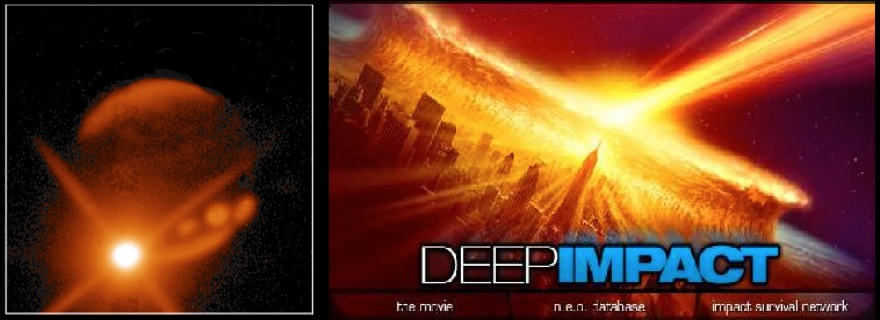
D. Potential Impact Scales
- City Buster: 15-m diam meteoroid ===> 106 tons TNT = 1 Megaton (MT). Serious local consequences, if it explodes at ground level. The atmosphere provides a partial shield for objects of this size. Explosions will be hydrogen-bomb scale but without the radioactivity. Both witnessed Russian impactors (see above) were in this category, but by virtue of atmospheric shielding they exploded at high altitude, doing less damage than they could have if they reached the surface.
- People Buster: 1-km diam asteroid ===> 250,000 MT. No atmospheric shield: atmospheric resistance has no effect on the incoming velocity of objects this large. Would produce hemispheric-scale effects; at the threshold for global effects. A significant fraction of all humans would be killed.
-
Planet Buster: 10-km diam asteroid ===> 250 million MT.
Global effects. Ejected, vaporized rock and water fill the
atmosphere, producing a "global winter" and a consequent major
extinction of lifeforms, including virtually all humans.
-
Note: you have already seen
pictures of Planet Buster-class asteroids (although
none of these has an Earth-crossing orbit)
E. Impact-Induced Bio-Extinctions?
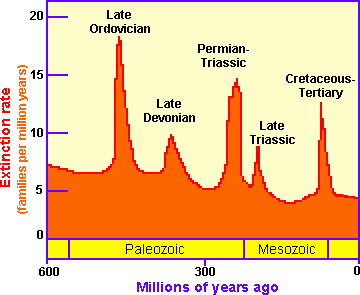 The fossil record (at right) shows that 5 great extinctions of
lifeforms on Earth occurred during the last 570 million years. These
are times where the fossil record abruptly changes character,
and many species vanish from more recent rocks. It is now
believed that most of these were probably induced by extraterrestrial
impacts.
The last great extinction was 65 million yrs ago at
the so-called
Cretaceous-Tertiary ("K-T") boundary in the fossil record.
The fossil record (at right) shows that 5 great extinctions of
lifeforms on Earth occurred during the last 570 million years. These
are times where the fossil record abruptly changes character,
and many species vanish from more recent rocks. It is now
believed that most of these were probably induced by extraterrestrial
impacts.
The last great extinction was 65 million yrs ago at
the so-called
Cretaceous-Tertiary ("K-T") boundary in the fossil record.
- Half of all species (not individuals) of plants and animals vanished.
- The non-avian dinosaurs, the largest land animals, were exterminated. This created an eco-niche for small mammals (our forebears)
An Extraterrestrial Origin for the K-T Event
- As first shown by Alvarez et al. in 1980, the sedimentary rock
layers at the K-T
boundary are abnormally rich in platinum group metals like
iridium. Their composition is like meteorites/asteroids, not
Earth crustal rocks, which were stripped of these materials when they
settled to the Earth's core. Deposition of the anomalous layers is
worldwide. The extraterrestrial origin of this extinction is now
virtually certain.
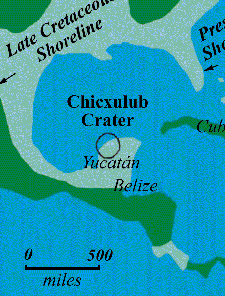
- The energy release involved would have required a 10-km diameter asteroid "planet-buster" impact.
- The site of the impact is now identified: Chicxulub crater, N. Yucatan. See map at right. The crater is 110 miles in diameter, and its age (via the radioisotope method) matches the extinction event (65 Myr ago). Debris deposits are scattered throughout the Caribbean area. The image here shows gravity and magnetic anomalies associated with the buried/undersea crater. See this Washington Post article for more details.
- Geologist Dewey McLean (of VPI) first proposed a connection between the KT extinction and massive volcanic eruptions at the Deccan Traps in India in 1978. Recently, more accurate dating and volume estimates for the Deccan Traps event show that the major outbreak there was essentially coincident with the KT event and the Chicxulub impact. This suggests that the impact (in what is now Mexico) may have triggered massive lava floods (in what is now India) that contributed to the extinction by pouring Greenhouse gases into the atmosphere.
Earlier Major Impacts
-
There is some evidence that the largest known
extinction, at the
Permian-Triassic boundary, 250 million years ago, which
extinguished 90% of all lifeforms on Earth, was also impact-related.
However, it is much harder to find impact tracers surviving from such
remote times because of crustal recycling.
Evidence for the Late Heavy Bombardment
on the Moon suggests that the Earth was subjected to a similar intense
storm of large impacts about 4 Byr ago. This may have been sufficient
to sterilize Earth's surface of any primitive lifeforms which had emerged
in the first 500 Myr of terrestrial history.
F. Risk Level?
We can crudely estimate the frequency of large impacts from the history of lunar cratering & bio-extinctions on Earth and our knowledge of the number of potential impactors of different sizes:-
E.g.: 5 great extinctions in 570 million years implies a rate of
about one global extinction (planet-buster) event per 100 million
years; the perpetrator would be a ~10-km diameter asteroid.
-
A Chelyabinsk-level event (20-m diameter impactor) will
occur about once every 80 years
A people-buster event (1-km diameter impactor killing 1/4 of
the human race) will occur about once per 150,000 years.
- In human terms, a people-buster event is very rare but very serious.
- Homo sapiens has existed for about 250,000 years and so has probably experienced, and survived, one or two people-buster events. However, humans did not develop written languages until about 5000 years ago, by which time earlier impact events would have probably disappeared from the oral tradition or become unrecognizable in a sea of myths.
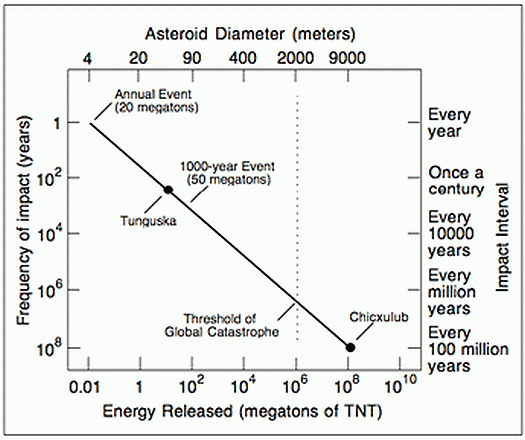
- Laughably small and forgettable, yes?
Well.....no. Many people actively worry about events with
comparable or smaller statistical probabilities: death from sharks,
nuclear power plant meltdowns, tidal waves, or poisonous snakes, for
instance.
- And, just to remind you of how low probability events can
become manifest, the massive 2011
Tohoku earthquake off Japan resulted in not only a deadly tidal
wave but also three nuclear reactor meltdowns!
G. Umbrellas
Various government agencies and private groups are consideration approaches to mitigating the danger of impacts on Earth.- First, we must identify threatening "Near Earth Objects"
(NEO's). A number of ground-based and space-based surveys,
described here,
have identified over 30,000 NEO's. The census is effectively complete
for the brighter, larger objects, but is deficient for those smaller
but still dangerous objects under 500-m in diameter.
- "Planet-busting" large asteroids (10-km) are relatively bright and we believe that almost all have already been identified. There are relatively few, and none pose a foreseeable threat.
- "People-busting" medium objects (1-km): it is estimated there are about 980 objects larger than 1 km in Earth-crossing orbits, of which 90% are now identified. There is no obvious near-term threat in this category.
- "City-busting" small objects (10--500-m): bad news. Too many (perhaps a million), too faint; search too expensive. We will have to "live" with these. (Tunguska and Chelyabinsk are in this class.) Over 5,000 with diameters larger than 100-m are known, but another 15,000 are expected in that range. A 2013 study found that the number of potential city-busting impactors may have been underestimated by as much as a factor of 10.
- A sobering footnote. NEO's are sorted into several categories, some of which do not actually cross Earth's orbit and therefore are not serious near-term threats. However, the orbits of such objects are continually changing because of gravitational interactions with the planets, including Earth. This means that we have to carefully calculate the future trajectory of all the NEO's to assess a realistic risk, taking into account all sources of uncertainty, and this is a demanding task.
- A more sobering footnote. The objects found in NEO surveys are asteroids and comets with relatively small semi-major axes (i.e. with orbits near the Sun). Threats that they pose, if any, are generally in the distant future and allow ample time for planning. Comet nuclei plunging in from the edge of the solar system could easily be in the dangerous impactor category (as was Comet Shoemaker-Levy 9), but we would have no way of detecting them until late in their approach (say at the distance of Saturn), implying little planning time. Making detection even harder is the fact that comets can come from all directions in space, whereas asteroids are more confined to the ecliptic plane.
- Second, we must develop technologies to eliminate them
- Best method: a gentle velocity deflection when they are still at large distance from Earth, enough to change their orbit such that they never intersect with Earth's orbit. Trying to break up potential impactors with explosives, as in the movie "Armageddon," could easily multiply the threat rather than prevent it.
- Requires new space technologies, e.g. an asteroid tugboat
- In a challenging test of deflection technologies, NASA's DART Mission produced a significant change in the orbit of the asteroid moon Dimorphos following a spacecraft impact in September 2022. DART showed that asteroid deflection is clearly feasible, though a mission to deflect a planet-buster size asteroid would have to be greatly scaled up.
- Following the asteroid 1997 XF11 public relations debacle, NASA established a Near Earth Object Program to oversee studies of potentially hazardous objects. In January 2016, NASA created the Planetary Defense Coordination Office charged with planning intergovernmental efforts to mitigate impact hazards.
H. Summing Up
Impacts from fragments of interplanetary material are not only dangerous to us, but they have also had dramatic effects on the development of life on Earth. Based on our (still incomplete) surveys to date, impacts do not present a looming threat to human welfare. However, we must learn to live with them or prevent them in the long run, and this will require a large investment of money, energy, and brainpower. The sooner we begin to make that, the better.Reading for this lecture:
-
Study Guide 22
Bennett textbook, Chapter 12
Optional reading:
-
Essay on
Impact Risk (Clark Chapman, 2002; PDF).
Dave Barry column on a "near miss"
Rain of Iron and Ice John S. Lewis (Clemons & SciEngr Lib: QB721.L42.1996)
-
Study Guide 23
Bennett textbook, Chapter 24
Web Links:
-
Big screen drama! Not just one but TWO big budget movies about
impacts appeared in 1998: Deep Impact and
Armageddon.
Former was OK, but Armageddon was hopelessly egregious
crap. For comments on the science content of these flix, see Bad
Astronomy.
-
Both movies lifted their plots from:
Lucifer's Hammer by Larry Niven & Jerry Pournelle (the best
comet-flattens-Earth novel)
Don't Look Up is a 2021 political satire film featuring a predicted comet impact on Earth.
Background on the K-T Extinction & Alternate Interpretations (UC Berkeley)
Earth Impact Database (UNB, Canada)
Terrestrial Impact Craters (information & images, C. J. Hamilton)
Google Earth Impact Structures Database
Resources on Impact Cratering in the Solar System
Chicxulub Crater and the K-T Boundary (Wikipedia) Volcano-Greenhouse Alternative for K-T Extinction (G. Keller, Princeton) Documentary Video on 1908 Tunguska Event
1908 Tunguska Event (Wikipedia) Compilation of real-time videos of the 2013 Chelyabinsk event Near Earth Object Resources Page (International Astronomical Union)
Near-Earth-Object Program (NASA-JPL)
Near Earth Object Risk Table (Current) (JPL)
Asteroid Mining Status of NEO Search Programs (Physics Today, September 2015) Status of NASA Planetary Defense Coordination Office (L. Johnson, January 2018) Upcoming Earth-Asteroid Encounters (TheSkyLive)
Past, Present, Future Close Encounters (Wikipedia)
List of Recent and Upcoming Earth-Asteroid Encounters (spaceweather.com) Earth Impact Effects Simulator (National Museum of Wales)
Earth Impact Effects Calculator (Imperial College, London) Near-encounter public relations flaps: Apophis: A major predicted flyby:
-
Asteroid
2004 MN4 (Apophis): This ~300-m diameter asteroid will pass
18,600 miles from Earth on April 13, 2029. Impact potential: 850
megatons. Will be visible as a 3rd magnitude object.
A Call to (Considered) Action on Asteroid 2004 MN4 from the B612 Foundation
 Previous Guide
Previous Guide
|
 Guide Index
Guide Index
|
 Next Guide
Next Guide
|